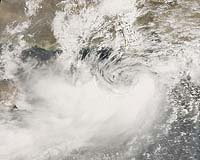| . |  |
. |
Tallahassee FL (SPX) Jun 03, 2010 Florida State University scientists who have developed a unique computer model with a knack for predicting hurricanes with unprecedented accuracy are forecasting an unusually active season this year. Associate Scholar Scientist Tim LaRow and his colleagues at FSU's Center for Ocean-Atmospheric Prediction Studies (COAPS) say there will be an average of 17 named storms with 10 of those storms developing into hurricanes in the Atlantic this season, which funs from June to November. \The historical seasonal average is 11 tropical storms with six of them becoming hurricanes. "It looks like it will be a very busy season, and it only takes one hurricane making landfall to have devastating effects," LaRow said. "The predicted high number of tropical systems means there is an increased chance that the eastern United States or Gulf Coast will see a landfall this year." The COAPS model, unveiled just last year, is one of only a handful of numerical models in the world being used to study seasonal hurricane activity, and it has already outperformed many other models. The model uses the university's high-performance computer to synthesize massive amounts of information including atmospheric, ocean and land data. A key component of the COAPS model is the use of predicted sea surface temperatures. The 2009 forecast, the model's first, was on target: It predicted a below-average season, with a mean of eight named storms with four of them developing into hurricanes. There were nine named storms with three that became hurricanes. The model's 2009 forecast, plus its hindcasts of the previous 14 hurricane seasons - that's when the data that existed prior to each season is plugged into the model to reforecast the season and then compared to what actually occurred - really show the model's precision. From 1995 to 2009, the model predicted a mean of 13.7 named storms of which a mean of 7.8 were hurricanes. In reality, the average during this period was 13.8 named storms with a mean of 7.9 hurricanes. How the oil spill in the Gulf of Mexico will affect the development of tropical storms this year is a question that scientists are still trying to figure out, LaRow said. The oil on the ocean surface can diminish the amount of surface evaporation, which would lead to local increased ocean temperatures near the surface, but LaRow said he's made no adjustments to the model to account for the oil that continues to gush from an underwater well. "The oil spill will probably have little influence on the hurricane season, but we don't know for sure since this spill is unprecedented," he said. "It's uncertain how exactly the atmospheric and oceanic conditions might change if the spill continues to grow." COAPS researchers spent about five years developing and assessing the numerical model before putting it to the test with its first real-time forecast last year. Numerical models require major computing resources in order to make trillions of calculations using the equations of motion along with the best physical understanding of the atmosphere. By contrast, statistical models, such as the one that produces Colorado State University's annual forecast, use statistical relationships between oceanic and atmospheric variables to make a forecast.
Share This Article With Planet Earth
Related Links Florida State University Bringing Order To A World Of Disasters When the Earth Quakes A world of storm and tempest
 Cyclone Phet hits Pakistan's coastline: officials
Cyclone Phet hits Pakistan's coastline: officialsKarachi (AFP) June 6, 2010 Cyclone Phet weakened Sunday after reaching two coastal districts of Pakistan's southern Sindh province, officials said. Heavy rains and winds lashed Karachi, the province's capital, killing at least four people as the cyclone swirled along Pakistan's coast after killing 15 people in Oman. "The cyclone moved rapidly eastwards in last six hours and went away from Karachi's coast" after hi ... read more |
|
| The content herein, unless otherwise known to be public domain, are Copyright 1995-2010 - SpaceDaily. AFP and UPI Wire Stories are copyright Agence France-Presse and United Press International. ESA Portal Reports are copyright European Space Agency. All NASA sourced material is public domain. Additional copyrights may apply in whole or part to other bona fide parties. Advertising does not imply endorsement,agreement or approval of any opinions, statements or information provided by SpaceDaily on any Web page published or hosted by SpaceDaily. Privacy Statement |